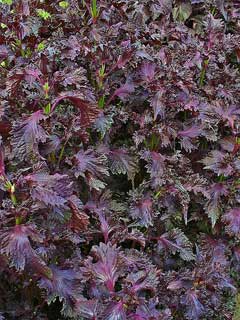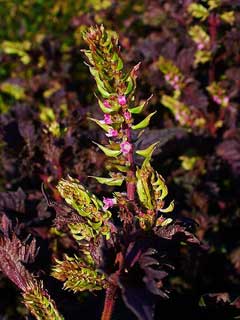 |
|
http://commons.wikimedia.org/wiki/User:Llez |
 |
| http://commons.wikimedia.org/wiki/User:Llez |
Translate this page:
Summary
Bloom Color: White. Main Bloom Time: Early summer, Late summer, Mid summer. Form: Upright or erect.
Physical Characteristics

 Perilla frutescens is a ANNUAL/PERENNIAL growing to 0.6 m (2ft) by 0.3 m (1ft in) at a fast rate.
Perilla frutescens is a ANNUAL/PERENNIAL growing to 0.6 m (2ft) by 0.3 m (1ft in) at a fast rate.
See above for USDA hardiness. It is hardy to UK zone 8 and is frost tender. It is in flower from July to August. The species is hermaphrodite (has both male and female organs).
Suitable for: light (sandy) and medium (loamy) soils and prefers well-drained soil. Suitable pH: mildly acid, neutral and basic (mildly alkaline) soils. It cannot grow in the shade. It prefers moist soil.
UK Hardiness Map
US Hardiness Map
Synonyms
P. ocimoides. L.
Plant Habitats
Cultivated Beds;
Edible Uses
Edible Parts: Flowers Leaves Oil Oil Seed
Edible Uses: Colouring Condiment Oil Oil
Edible young leaves and seedlings - raw or cooked[46, 116, 178, 183]. The flavour is strange to western palates at first, some people detecting cinnamon, others coriander or citrus[206]. Seedlings are added to salads, older leaves are used as a garnish or flavouring[206]. Older leaves are also salted and used as a condiment for tofu and as a garnish for tempura[183]. Leaves from purple cultivars are used to colour preserved fruits[238]. The leaves can also be dried for later use[206]. The leaves contain about 3.1% protein, 0.8% fat, 4.1% carbohydrate, 1.1% ash[179]. Immature flower clusters are used as a garnish for soups and chilled tofu[183]. Older flower clusters are fried and eaten[183]. The seeds are preserved in salt or are used as a spice in pickles, tempura and miso[183, 206]. They are one of the ingredients in 'Shichimi' or 'seven spice' mixture[206]. The seed can also be eaten cooked[105, 178]. Seeds from purple-leafed forms of the plant are preferred for culinary use[238]. The seed contains about 21.5% protein, 43.4% fat, 11.3% carbohydrate, 4.4% ash[179]. An edible drying oil is obtained from the seed[46, 171, 183, 272]. It is rich in linolenic acid[57]. The plant yields an essential oil which is used as a food flavouring in candies and sauces[183].
References More on Edible Uses
Medicinal Uses
Plants For A Future can not take any responsibility for any adverse effects from the use of plants. Always seek advice from a professional before using a plant medicinally.
Antiasthmatic Antibacterial Antidote Antipyretic Antiseptic Antispasmodic Antitussive Aromatic
Carminative Diaphoretic Emollient Expectorant Pectoral Stomachic Tonic
The leaves, stems and seeds of shiso are often used in Oriental medicine. It is a pungent, aromatic, warming herb that is antibacterial, antidote, antipyretic, antiseptic, antispasmodic, antitussive, aromatic, carminative, diaphoretic, emollient, expectorant, pectoral, stomachic and tonic[116, 147, 174, 176, 218, 238]. The leaves are used in the treatment of colds, chest stuffiness, vomiting, abdominal pain etc[176]. The juice of the leaves is applied to cuts and wounds[272]. The seed is antiasthmatic, antitussive, emollient and expectorant[176]. It is used internally in the treatment of asthma, colds and chills, nausea, abdominal pain, food poisoning and allergic reactions (especially from seafood), bronchitis and constipation[218, 238]. The stems are a traditional Chinese remedy for morning sickness[238].]. This herb should be avoided by pregnant women[222].
References More on Medicinal Uses
The Bookshop: Edible Plant Books
Our Latest books on Perennial Plants For Food Forests and Permaculture Gardens in paperback or digital formats.

Edible Tropical Plants
Food Forest Plants for Hotter Conditions: 250+ Plants For Tropical Food Forests & Permaculture Gardens.
More

Edible Temperate Plants
Plants for Your Food Forest: 500 Plants for Temperate Food Forests & Permaculture Gardens.
More

More Books
PFAF have eight books available in paperback and digital formats. Browse the shop for more information.
Shop Now
Other Uses
Essential Oil Oil
A drying oil obtained from the seed is used in making paints, varnishes, water proofing etc[46, 57, 105, 171, 238]. The plant yields 0.3 - 1.3% essential oil, which contains 20% citral[240]. It is used as a food flavouring and in dental products[238]. Attractive leaves.
Special Uses
Food Forest Scented Plants
References More on Other Uses
Cultivation details
Landscape Uses:Border, Container, Specimen. Prefers a light soil[1, 206]. Requires a rich well-drained moisture-retentive soil in full sun[200]. Plants require a well-drained soil but do not need particularly fertile soil[206]. Prefers an acid soil with a pH between 5.5 and 6[206]. The plant is not frost hardy and requires temperatures above 18°c if it is to grow well[206]. The plant requires short days in order to flower[206]. Shiso is often cultivated in the Orient as a food flavouring. There are some named varieties, those with purple leaves being preferred for seed production[183, 206, 238]. Shiso is also cultivated for the oil obtained from its seed[50, 171]. It is sometimes used in sub-tropical bedding schemes in Britain[1]. Special Features:Attractive foliage, Invasive, Naturalizing. In garden design, as well as the above-ground architecture of a plant, root structure considerations help in choosing plants that work together for their optimal soil requirements including nutrients and water. The root pattern is flat with shallow roots spreading near the soil surface [2-1].
References Carbon Farming Information and Carbon Sequestration Information
Temperature Converter
Type a value in the Celsius field to convert the value to Fahrenheit:
Fahrenheit:
The PFAF Bookshop
Plants For A Future have a number of books available in paperback and digital form. Book titles include Edible Plants, Edible Perennials, Edible Trees,Edible Shrubs, Woodland Gardening, and Temperate Food Forest Plants. Our new book is Food Forest Plants For Hotter Conditions (Tropical and Sub-Tropical).
Shop Now
Plant Propagation
Surface-sow or only lightly cover the seed in mid spring in a greenhouse. The seed germinates best at 20°c, though it also succeeds at slightly lower temperatures[206]. Germination is usually quick, prick out the seedlings into trays or individual pots when they are large enough to handle and plant them out into their permanent positions in early summer[200, K]. Give the plants some protection such as a cloche until they are growing away well. The seed has a short viability and should be used when less than a year old[206].
Other Names
If available other names are mentioned here
Native Range
TEMPERATE ASIA: China (Fujian Sheng, Guangdong Sheng, Guangxi Zhuangzu Zizhiqu, Guizhou Sheng, Hebei Sheng, Hubei Sheng, Jiangsu Sheng, Jiangxi Sheng, Shanxi Sheng, Sichuan Sheng, Xizang Zizhiqu, Yunnan Sheng, Zhejiang Sheng), Korea, Japan (Honshu, Kyushu, Shikoku), Taiwan TROPICAL ASIA: Bhutan, India (north), Nepal, Pakistan, Cambodia, Laos, Myanmar, Thailand, Vietnam
Weed Potential
Right plant wrong place. We are currently updating this section.
Please note that a plant may be invasive in one area but may not in your area so it's worth checking.
Conservation Status
IUCN Red List of Threatened Plants Status :

Growth: S = slow M = medium F = fast. Soil: L = light (sandy) M = medium H = heavy (clay). pH: A = acid N = neutral B = basic (alkaline). Shade: F = full shade S = semi-shade N = no shade. Moisture: D = dry M = Moist We = wet Wa = water.
Now available:
Food Forest Plants for Mediterranean Conditions
350+ Perennial Plants For Mediterranean and Drier Food Forests and Permaculture Gardens.
[Paperback and eBook]
This is the third in Plants For A Future's series of plant guides for food forests tailored to
specific climate zones. Following volumes on temperate and tropical ecosystems, this book focuses
on species suited to Mediterranean conditions—regions with hot, dry summers and cool, wet winters,
often facing the added challenge of climate change.
Read More
Expert comment
Author
(L.)Britton.
Botanical References
58200
Links / References
For a list of references used on this page please go here
Readers comment
| Add a comment |
|
If you have important information about this plant that may help other users please add a comment or link below. Only comments or links that are felt to be directly relevant to a plant will be included. If you think a comment/link or information contained on this page is inaccurate or misleading we would welcome your feedback at [email protected]. If you have questions about a plant please use the Forum on this website as we do not have the resources to answer questions ourselves.
* Please note: the comments by website users are not necessarily those held by PFAF and may give misleading or inaccurate information.
To leave a comment please Register or login here All comments need to be approved so will not appear immediately.
|
Subject : Perilla frutescens
|
|
|
|